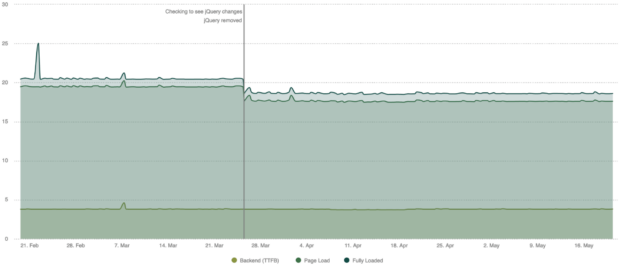
In the first blog post we covered "How and why we removed jQuery from GOV.UK", let’s now turn our attention to what performance difference it has made for users. Please read that blog post before this one.
Image data versus compressed data
As mentioned previously, the jQuery library was only 32 Kb of compressed and minified (when white space removed from code and repeated words substituted) JavaScript. Now I know what you may be thinking, that doesn’t sound like a lot of data, especially compared to images which can be multiple megabytes in size. But when it’s on every page, from a web performance perspective, it equates to a lot of data. It’s also worth mentioning that there’s a big difference between image data and compressed JavaScript data. Browsers and devices handle the 2 data types very differently.
JavaScript is known as a “render-blocking” resource. This means when a browser encounters JavaScript it goes through a multistep process which involves it being downloaded, then uncompressed, before it’s finally parsed and executed. This all happens within a device's available Central Processing Unit (CPU) and memory. These tasks can be very slow and energy intensive depending on the device and connection.
Unfortunately, during this time, the actual drawing of pixels to the device's screen has to be paused until the execution of the JavaScript is completed. Upon completion the browser can then continue to paint pixels for the rest of the page.
Images and image data aren't “render-blocking”, meaning parts of the webpage can be painted to the page while additional image data is being downloaded in parallel. Therefore, a 32 Kb image has much less of a performance impact than 32 Kb of compressed JavaScript. This is especially true for users on low specification devices that are generally slower, older and less expensive.
We will focus on these users for the rest of the blog post.
Helping users with low specification devices
Lower specification devices are often considered to be older laptops and tablets, or ‘budget’ mobile devices (often Android devices on a limited data plan).
Since these users have the slowest devices, they’ll need the most help to make sure their visit to GOV.UK is as fast, efficient and as cheap as possible. Last October, Ofcom estimated 2 million households were "experiencing affordability issues with either their fixed broadband and/or smartphone", so our work here has the potential to reduce their internet costs.

At this point, it’s worth mentioning that the anonymous Real User Monitoring (RUM) data we collect from user devices shows that GOV.UK is already a very quick website. For the majority of users, the site loads in less than 1 second. But the distribution graph (seen above) also shows that there are some users that see a page load time of up to 2.35 seconds. Examining these users’ RUM performance data more closely, we see:
- 75% of users are based in the UK
- 35% of users are on an Android device
- it’s taking almost 2 seconds for the first page pixels to display on their screens (this is called the start render metric)
From the statistics above, we can assume it’s highly likely that many of these Android users are on low specification devices where CPU speed and memory capacity is limited.
With that assumption in mind, what performance impact will removing 32 kB of compressed JavaScript have?
Testing the impact
This is where our “lab-based” performance testing is very useful. We run tests every day on GOV.UK pages using specific simulated devices and connection speeds. Because we can repeat these tests every day, it allows us to monitor what the changes we are making to the site are doing for real users visiting GOV.UK.
For example, for a simulated user visiting the Universal Credit start page on a low specification device and 2G mobile connection, we can clearly see from the graph where the jQuery change was made.

The reason why the Universal Credit page was chosen is because it’s the most visited page on GOV.UK according to our analytics data, so it is important that it loads quickly for all users, no matter what device or connection they are using. As the graph above shows, the time it took for the page to completely draw the pixels to the screen (visually complete) dropped from 11.3 seconds to 9.4 seconds (a 17% improvement).
As well as visually complete Improvements, page load time improvements were also clearly seen. The graph below shows the time until the page has fully loaded dropped from 20.42 seconds to 18.75 seconds (an 8% improvement) and total page load time dropped from 19.44 seconds to 17.75 seconds (a 9% improvement).

Finally, we also see a significant improvement in the page's interactive performance metrics, meaning a user can interact with the page a lot sooner. Interactivity metrics are important to users as they show when the user can first interact with the page. Being able to interact with a page gives users confidence that the page is still working.
The graph below shows time to interactivity dropped from 11.34 seconds to 9.43 seconds (an improvement of 17%), and the devices First CPU idle dropped from 11.32 seconds to 9.42 seconds (an improvement of 17%).

Improving GOV.UK for everyone
Improving web performance is often made up of lots of smaller incremental changes over time. So it’s been great to see support for this change from the wider web performance community.
As you can see from our performance monitoring results above, we have improved page performance for many users who struggle on low specification devices and slow connections, even though GOV.UK is already a very quick website for the majority of users. It may sound like 32 kb of JavaScript is nothing on today's modern web with quick devices and fast broadband connections. But for a certain cohort of users, it makes a big difference to how they experience GOV.UK.
If you’re interested in this work, why not join the team? Apply to work at GDS
 The GOV.UK app went live in public beta in July 2025. Find out what’s been happening, and what’s coming next,
The GOV.UK app went live in public beta in July 2025. Find out what’s been happening, and what’s coming next,
18 comments
Comment by Barnok Balavan posted on
Honestly, I think the whole case for removing jQuery is overstated.
It's a tiny library that allows developers to write very terse code that overcomes browser differences without issue. The tests quoted are unrealistic worst case scenarios: "The graph below shows the time until the page has fully loaded dropped from 20.42 seconds". Nobody waits that long. Those numbers sound cooked, frankly.
Comment by Jon posted on
"For example, for a simulated user visiting the Universal Credit start page on a low specification device and 2G mobile connection, we can clearly see from the graph where the jQuery change was made."
Comment by Dave Howes posted on
There speaks a man with a fast device and connection who's utterly failed to understand any of the page he's just read :~)
Comment by Mr Oz posted on
Your privilege is showing the "cooked" data is out there: https://httparchive.org/reports/loading-speed#ol
Read the comments:
https://www.bbc.co.uk/news/technology-48458280#comments
"3g would be good to have in some parts of the country!!!"
"I still have to walk around my Essex garden trying to obtain a phone line let alone 5G."
Comment by CK posted on
@Barnok: Oh dear, you missed the point.
@Gov.uk: Good work guys, I roll my own and it makes a noticeable difference on older devices. Plenty of people still using them.
Please work on streamlining the self assessment tax returns next, I hate them 🙂
Comment by CK posted on
hmmm, seems comments are removed even if they support gov.uk...weird
Comment by Ka posted on
Does this page play a “ding” at the end? it really scare me, I am try to found out if my glass fallen, LOL.
Comment by Mads posted on
It would be interesting to know if asset caching or deferred loading was used, prior to ditching jQuery, and/or if the daily tests ran in a no-cache configuration.
Disabling the cache will give you the worst-case scenario, you're probably looking for, but it also does skew the results a bit.
What would the results be, if the browser could just pull the JavaScript from the cache and save the 2G roundtrip or even just deferred JavaScript loading?
It's not really obvious, from the little info we get about your RUM data, if the 17% with the "bad experience" are all just first time visitors or if they get the same experience on repeat visits.
Otherwise interesting post(s) on real-world improvements.
Comment by Matt Hobbs posted on
Hi thanks for your questions,
For the daily synthetic testing by default nothing is cached between tests, this is the default for WebPageTest on which the synthetic tests are built, unless you set it up for repeat views with cache persistence, the idea with these tests is to identify worse case scenarios given how aggressive browser caching can be on resource limited devices I'm not sure how long assets would be kept in their cache, but I do agree it will likely skew the results.
I know Facebook and Yahoo studied cache efficiency on devices / browsers back in 2015 (https://engineering.fb.com/2015/04/13/web/web-performance-cache-efficiency-exercise/) and found the browsers at the time to be very aggressive with cache life, I'm assuming this will likely still be true for low spec devices (I'd love to see an updated study for 2022).
The 2G question is an excellent one and something we are working on at the moment. As GOV.UK has a number of FE rendering apps, a user's journey across the website involves multiple rendering apps which don't always use the same assets for each page. This means that it's currently likely a user is always going to be in a position where there is something not sitting in the browser cache, and will need to be loaded on the next page (we know not ideal at all, but architectural constraints from years ago are still a limitation with this).
For the RUM data question, the RUM tool we use gathers anonymous data across a user's journey and then splits them into the load time histogram you see above. This means we cannot determine if the visit is a new or repeat visitor - details are in GOV.UK’s Privacy Notice (https://www.gov.uk/help/privacy-notice). What we do know is that 17% of users do get a bad experience, so let's concentrate on trying to improve that statistic and fix it for both new and returning visitors.
I hope that helps answer some of your questions.
Thanks, Matt
Comment by dfl posted on
This is a wonderful analysis of a case where jQuery was just sitting idly in the page.
However, for pages that actually *use* jQuery, the question is - what was it used for and what alternative has been deployed.
Not to sound dismissive - this post is very useful for web authors who include jQuery, or any other asset, for religious or other non functional reasons. This is obviously the common case. However, for the tiny minority that are including libraries and actually *using* them, the value of the post is quite limited.
Comment by Andy Sellick posted on
Hi thanks for your questions,
We saw jQuery as technical debt that would eventually be removed from GOV.UK. It should have been mentioned in the post, but we have nothing against jQuery - it was (and still is) an excellent library if you need to support older browsers with an easy-to-use JavaScript API. However, we wanted to tackle the technical debt and being on an older version at the same time.
jQuery was being used widely across http://www.gov.uk on nearly every page. The replacement for jQuery was to rewrite the same functionality using plain JavaScript. This did involve the addition of some extra lines since “vanilla” JavaScript is sometimes less streamlined than jQuery. But it did allow us to remove an out-of-date third party dependency and set the precedent for not using one again in the future.
Part of the aim of these posts is to show that with teamwork and perseverance it is possible to make changes to large platforms that have been live for many years. We also wanted to show that technical debt can be rectified, and developer dependency on third-party libraries can be reduced. As of 2021 jQuery is still the most popular library in use on the internet (https://almanac.httparchive.org/en/2021/javascript#libraries-usage), so there are going to be a lot of teams in the future who may need to complete this task too.
Thanks, Andy
Comment by Nige posted on
This article is misleading as it uses 2G speeds for the final comparison. The actual benefit to the slowest-loading of your visitors is more like 0.2 seconds rather than 2 seconds, while increasing pressure on your web developers who can no longer use the convenience functions jQuery provides.
Comment by Proteus posted on
The article writes: "But when it’s on every page, from a web performance perspective, it equates to a lot of data".
Each script is downloaded once. It's not a lot of data, it's a single download, and then it's cached in memory.
Further, when you remove jquery, you have to replace it with something else and refactor the entire site - because (guess what!), jquery was used by other scripts. So the comparison is rather tricky.
This, of course, is trivial knowledge to any developer that has spent a few minutes writing simple javascript code.
To put it mildly, this whole article is not very scientific.
Comment by Mr Oz posted on
Why would a team want to continue using a 3rd party with a known security issues? It's technical debt at the end of the day, Unless they just leave everything in there forever?? That sounds like a terrible idea!
Well done to the team working on this! The privilege of some people on some of the comments in this post is really terrible. Empathy for others at all??
As I mentioned in another reply feel free to read comments from this article: https://www.bbc.co.uk/news/technology-48458280#comments
Some folks in the country can't even get a stable 3G connection let alone high speed internet, gov.uk has to cater for everyone, not just people on high speed connections and the latest mobile device. I'm sure many people are very happy they can get to gov.uk content on low specification devices!
Comment by ManoDestra posted on
jQuery was fine back in the day when browser compatibility was a serious concern, but this is no longer the case. That, along with the security aspect and the additional skill requirement, are all great reasons to ditch it along with the obvious performance benefit especially on low end devices.
We made the same change recently at my company and haven't looked back (despite some initial resistance). So much better off without it. Good riddance, I say, and roll your own!
Comment by Hahah posted on
Haha. I have a better idea. Just turn off the javascript at all, host the site on Nginx and voila, you will have a duper duper fast website loading and of course, last but not least one of ugliest and usesless website in the world.
Comment by Dave Methvin posted on
Something is strange with the scripts on, for example, the http://www.gov.uk site. There is a lot of duplicated code in the two files loaded at the bottom of the page, and it seems to include a shim that mentions IE8! Whatever bundler being used is pulling in the same code several times. The site would be faster if all that duplication was eliminated.
Comment by Matt Hobbs and Andy Sellick posted on
Hi Dave,
You’re right, there is some duplication in the JavaScript, but this is minimised through the Brotli compression technologies we employ on the Content Delivery Network (CDN) when delivering scripts to browsers. Having said that, there are still things we can do to improve the speed of the site further, and we’ll continue to work to improve things.
We don’t fully support Internet Explorer 8 any more (see https://www.gov.uk/service-manual/technology/designing-for-different-browsers-and-devices#browsers-to-test-in-from-june-2022) but a significant number of people are still using older browsers to access GOV.UK. The Design System team are currently working on improving the experience of our IE8 users by optimising the JavaScript delivered to this browser by only delivering the JavaScript that is essential for a page to work in IE8. This work will filter through to the GOV.UK platform once they upgrade to version 5.x of the design system.
Thanks, Matt and Andy